Chapter: Psychology: Thinking
Mental Representations
MENTAL REPRESENTATIONS
Common sense tells us that we’re
able to think about objects or events not currently in view. Thus, you can
decide whether you want the chocolate ice cream or the strawberry before either
is delivered. Likewise, you can draw conclusions about George by remem-bering
how he acted at the party, even though the party was two weeks ago and a
hun-dred miles away. In these (and many other cases), our thoughts must involve
mentalrepresentations—contents in
the mind that stand for some object or event or state ofaffairs, allowing us to
think about those objects or events even in their absence.
Mental representations can also
stand for objects or events that exist only
in our minds—including fantasy objects, like unicorns or Hogwarts School,
or impossible objects, like the precise
value of pi. And even when we’re thinking about objects in plain view,
mental representations still have a role to play. If you’re thinking about this
page, for example, you might represent it for yourself in many ways: “a page
from the Thinking,” or “a piece of paper,” or “something colored white,” and so
on. These different ideas all refer to the same physical object—but it’s the
ideas (the men-tal representations), not the physical object, that matter for
thought. (Imagine, for example, that you were hunting for something to start a
fire with; for that, it might be helpful to think of this page as a piece of
paper rather than a carrier of information.)
Mental representations of all
sorts provide the content for our thoughts. Said differ-ently, what we call
“thinking” is just the set of operations we apply to our mental rep-resentations—analyzing
them, contemplating them, and comparing them in order to draw conclusions,
solve problems, and more. However, the nature of the operations applied to our
mental operations varies—in part because mental representations come in
different forms, and each form requires its own type of operations.
Distinguishing Images and Symbols
Some of our mental
representations are analogical—they
capture some of the actual characteristics of (and so are analogous to) what
they represent. Analogical representa-tions usually take the form of mental images. In contrast, other
representations are symbolic and
don’t in any way resemble the item they stand for.
To illustrate the difference
between images and symbols, consider a drawing of a cat (Figure 9.1). The picture
consists of marks on paper, but the actual cat is flesh and blood. Clearly,
therefore, the picture is not equivalent to a cat; it’s merely a
representa-tion of one. Even so, the picture has many similarities to the
creature it represents, so that, in general, the picture looks in some ways
like a cat: The cat’s eyes are side by side in reality, and they’re side by
side in the picture; the cat’s ears and tail are at opposite ends of the
creature, and they’re at opposite ends in the picture. It’s properties like
these that make the picture a type of analogical representation.
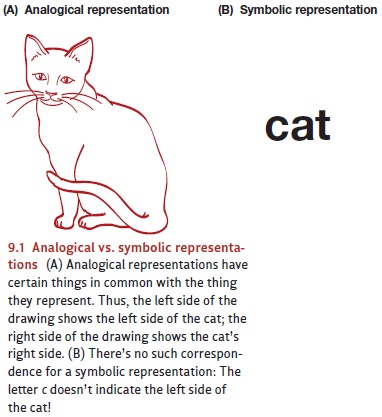
In contrast, consider the word cat. Unlike a picture, the word in no
way resembles the cat. The letter c
doesn’t represent the left-hand edge of the cat, nor does the overall shape of
the word in any way indicate the shape of this feline. The word, therefore, is
an entirely abstract representation, and the rela-tion between the three
letters c-a-t and the animal they
represent is essentially arbitrary.
For some thoughts, mental images
seem crucial. (Try thinking about a particular shade of blue, or try to recall
whether a horse’s ears are rounded at the top or slightly pointed. The odds are
good that these thoughts will call mental images to mind.) For other thoughts,
you probably need a symbolic representation. (Think about the causes of global
warming; this thought may call images to mind—perhaps smoke pouring out of a
car’s exhaust pipes—but it’s likely that your thoughtspecifies relationships
and issues not captured in the images at all.)For still other thoughts, it’s
largely up to you how to represent thethought, and the form of representation
is often consequential. If you form a mental image of a cat, for example, you
may be reminded of other animals that look like the cat—and so you may find
yourself thinking about lions or tigers. If you think about cats without a
mental image, this may call a different set of ideas to mind—perhaps thoughts
about other types of pet. In this way, the type of representation can shape the
flow of your thoughts—and thus can influence your judgments, your decisions,
and more.
Mental Images
People often refer to their
mental images as “mental pictures” and comment that they inspect these
“pictures” with the “mind’s eye.” In fact, references to a mind’s eye have been
part of our language at least since the days of Shakespeare, who used the
phrase in Act 1 of Hamlet. But, of
course, there is no (literal) mind’s eye—no tiny eye somewhere inside the
brain. Likewise, mental pictures cannot be actual pictures: With no eye deep
inside the brain, who or what would inspect such pictures?
Why, then, do people describe
their images as mental pictures? This usage presum-ably reflects the fact that
images resemble pictures in some ways, but that simply invites the next
question: What is this resemblance? A key part of the answer involves spatial
layout. In a classic study, research participants were first shown the map of a
fictitious island containing various objects: a hut, a well, a tree, and so on
(Kosslyn, Ball, & Reisser, 1978; Figure 9.2). After memorizing this map,
the participants were asked to
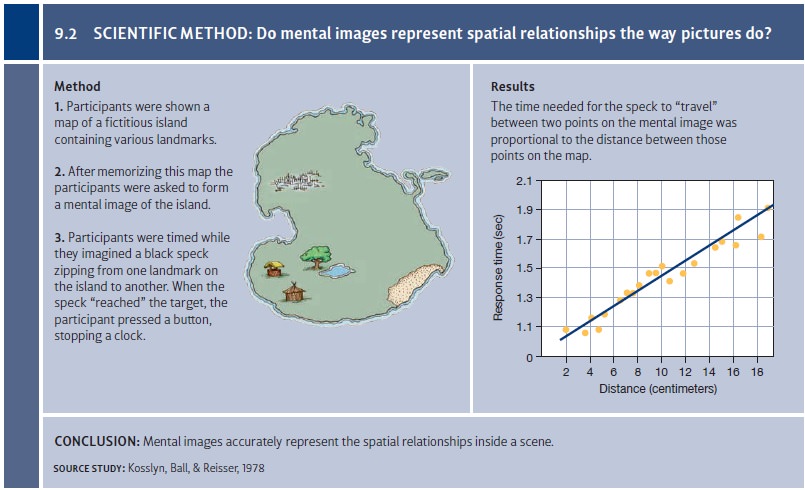
form a mental image of the
island. The experimenters then named two objects on the map (e.g., the hut and
the tree), and participants had to imagine a black speck zipping from the first
location to the second; when the speck “reached” the target, the partici-pant
pressed a button, stopping a clock. Then the experimenters did the same for
another pair of objects—say the tree and the well—and so on for all the various
pairs of objects on the island.
The results showed that the time
needed for the speck to “travel” across the image was directly proportional to
the distance between the two points on the original map. Thus, participants
needed little time to scan from the pond to the tree; scanning from the pond to
the hut (roughly four times the distance) took roughly four times as long;
scanning from the hut to the patch of grass took even longer. Apparently, then,
the image accurately depicted the map’s geometric arrangement: Points close
together on the map were somehow close to each other in the image; points
farther apart on the map were more distant in the image. In this way, the image
is unmistakably picture-like, even if it’s not literally a picture.
Related evidence indicates
enormous overlap between the brain areas crucial for cre-ating and examining
mental images and the brain areas crucial for visual perception. Specifically,
neuroimaging studies show that many of the same brain structures (prima-rily in
the occipital lobe) are active during both visual perception and visual imagery
(Figure 9.3). In fact, the parallels between these two activities are quite
precise: When people imagine movement patterns, high levels of activation are
observed in brain areas that are sensitive to motion in ordinary perception.
Likewise, for very detailed images, the brain areas that are especially
activated tend to be those crucial for perceiving fine detail in a stimulus
(Behrmann, 2000; Thompson & Kosslyn, 2000).

Further evidence comes from
studies using transcranial magnetic stimulation. Using this technique,
researchers have produced temporary disruptions in the visual cortex of healthy
volunteers—and, as expected, this causes problems in seeing. What’s important
here is that this procedure also causes parallel problems in visual
imagery—consistent with the idea that this brain region is crucial both for the
processing of visual inputs and for the creation and inspection of images
(Kosslyn, Pascual-Leone, Felician, Camposano, Keenan et al., 1999).
All of these results powerfully
confirm that visual images are indeed picture-like; and they lend credence to
the often-heard report that people can “think in pictures.” Be aware, though,
that visual images are picture-like,
but not pictures. In one study, partic-ipants were shown the drawing in Figure
9.4 and asked to memorize it (Chambers & Reisberg, 1985; also Reisberg
& Heuer, 2005). The figure was then removed, and partic-ipants were asked
to form a mental image of this now absent figure and to describe their image.
Some participants reported that they could vividly see a duck facing to the
left; others reported seeing a rabbit facing to the right. The participants
were then told there was another way to perceive the figure and asked if they
could reinterpret the image, just as they had reinterpreted a series of
practice figures a few moments earlier. Given this task, not one of the participants
was able to reinterpret the form. Even with hints and considerable coaxing,
none were able to find a duck in a “rabbit image” or a rabbit in a “duck
image.” The participants were then given a piece of paper and asked to draw the
figure they had just been imagining; every participant was now able to come up
with the perceptual alternative.
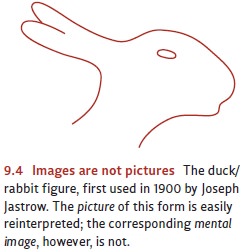
These findings make it clear that
a visual image is different from a picture. The pic-ture of the duck/rabbit is easily reinterpreted; the
corresponding image is not. This
isbecause the image is already organized and interpreted to some extent (e.g.,
facing “to the left” or “to the right”), and this interpretation shapes what
the imaged form seems to resemble and what the imaged form will call to mind.
Propositions
As we’ve seen, mental images—and
analogical representations in general—are essen- tial for representing some
types of information.
Other information, in
contrast, requires a symbolic representation. This type of mental
representation is more flexible because
symbols can represent
any content we
choose, thanks to
the fact that
it’s entirely up to us what each symbol stands for. Thus, we can use the
word mole to stand for an animal that digs in the ground, or we could use the
word (as Spanish speakers do) to refer to a type of sauce used in cooking.
Likewise, we can use the word cat to refer to
your pet, Snowflake; but, if we
wished, we could instead
use the Romanian
word pisica˘ as the symbol representing your pet, or we could use the
arbitrary designation X2$. (Of course, for communicating with others, it’s
important that we use the same terms they do. This is not an issue, however,
when we’re representing thoughts in ou own minds.)
Crucially, symbols can also be
combined with each other to represent more complex contents—such as “San Diego
is in California,” or “cigarette smoking is bad for your health.” There is
debate about the exact nature of these combinations, but many schol- ars
propose that symbols can be assembled into propositions—statements that relate
a subject (the item about which the statement is being made) and a predicate
(what’s being asserted about the
subject). For example, “Solomon loves to blow glass,” “Jacob lived in Poland,”
and “Squirrels eat burritos” are all propositions (although the first two are
true, and the last is false). But just the word Susan or the phrase “is
squeamish” aren’t propositions—the first is a subject without a predicate; the
second is a predicate without a subject. (For more on how propositions are
structured and the role they play in our thoughts, see J. Anderson, 1993, 1996.)It’s
easy to express propositions as sentences, but this is just a convenience; many
other formats are possible. In the mind, propositions are probably expressed
via net- work structures, related to the network models. Individual symbols
serve as nodes
within the network—meeting places
for various links—so if we were
to draw a picture of the network, the nodes would look like knots in a
fisherman’s net, and this
is the origin
of the term
node (derived from
the Latinnodus, meaning “knot”).
The individual nodes are connected to each other by
associative links (Figure
9.5). Thus, in this system
there might be a node representing Abe
Lincoln and another node repre-
senting President, and the link between
them represents part of our knowledge about Lincoln—namely, that he was a
president. Other links have labels
on them, as
shown in Figure
9.6; these labels allow
us to specify
other relationships among
nodes, and in this way we can use the network to express
any proposition at all (after J. Anderson, 1993, 1996).
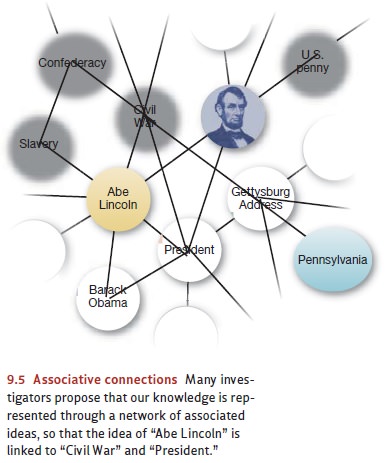
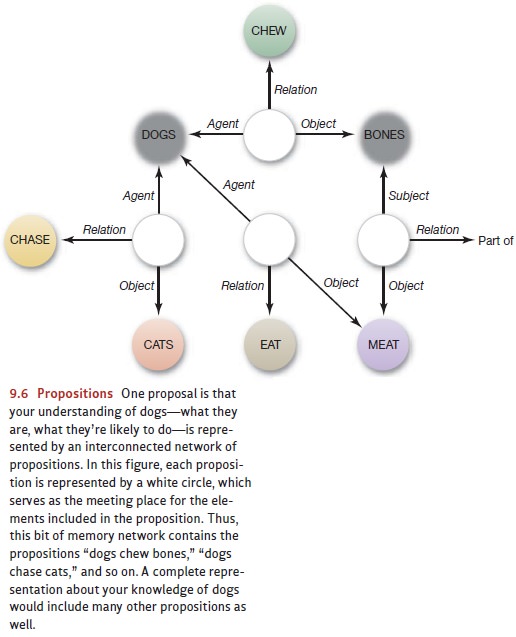
The various nodes representing a
proposition are activated when- ever
a person is
thinking about that
proposition. This activation then spreads
to neighboring nodes, through the associative links, much
as electric current
spreads through a
network of wires.
However, this
spread of activation
will be weaker
(and will occur more
slowly) between nodes
that are only
weakly associated. The
spreading activation will
also dissipate as it spreads
outward, so that little or no activation will reach the nodes more
distant from the activation’s source.
In fact, we can follow the spread of activation directly. In a classic study, participants were presented with two strings of letters, like NARDE–DOCTOR, or GARDEN–DOCTOR, or NURSE–DOCTOR (Meyer & Schvaneveldt, 1971). The participants’ job was to press a “yes” button if both sequences were real words (as in the second and third examples here), and a “no” button if either was not a word (the first example). Our interest here is only in the two pairs that required a yes response. (In these tasks, the no items serve only as catch trials, ensuring that partici-pants really are doing the task as they were instructed.)
Let’s consider a trial in which
participants see a related pair, like NURSE– DOCTOR. In choosing a response,
they first need to confirm that, yes, NURSE is a real word in English. To do
this, they presumably need to locate the word NURSE in their mental dictionary;
once they find it, they can be sure that these letters do form a legitimate
word. What this means, though, is that they will have searched for, and
activated, the node in memory that represents this word—and this, we have
hypothe-sized, will trigger a spread of activation outward from the node,
bringing activation to other, nearby nodes. These nearby nodes will surely
include the node for DOCTOR, since there’s a strong association between “nurse”
and “doctor.” Therefore, once the node for NURSE is activated, some activation
should also spread to the node for DOCTOR.
Once they’ve dealt with NURSE,
the participants can turn their attention to the sec-ond word in the pair. To make a decision about DOCTOR (is
this string a word or not?), the participants must locate the node for this
word in memory. If they find the relevant node, then they know that this
string, too, is a word and can hit the “yes” button. But of course the process
of activating the node for DOCTOR has already begun, thanks to the activation
this node just received from the node for NURSE. This should accelerate the
process of bringing the DOCTOR node to threshold (since it’s already partway
there), and so it will take less time to activate. Hence, we expect quicker
responses to DOCTOR in this context, compared to a context in which it was
preceded by some unrelated word and therefore not primed. This prediction is
correct. Participants’ lexi-cal decision responses are faster by almost 100 milliseconds
if the stimulus words are related, so that the first word can prime the second
in the way we just described.
We’ve described this sequence of
events within a relatively uninteresting task— participants merely deciding
whether letter strings are words in English or not. But the
same dynamic—with one node
priming other, nearby nodes—plays a role in, and can shape, the flow of our
thoughts. For example, we mentioned that the sequence of ideas in a dream is
shaped by which nodes are primed. Likewise, in problem solving, we sometimes
have to hunt through memory, looking for ideas about how to tackle the problem
we’re confronting. In this process, we’re plainly guided by the pattern of
which nodes are activated (and so more available) and which nodes aren’t. This
pat-tern of activation in turn depends on how the nodes are connected to each
other—and so the arrangement of our knowledge within long-term memory can have
a powerful impact on whether we’ll locate a problem’s solution.
Related Topics